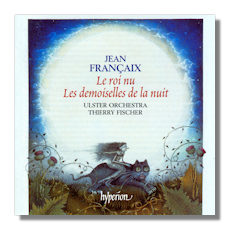
The Internet's Premier Classical Music Source
Related Links
- Françaix Reviews
- Latest Reviews
- More Reviews
-
By Composer
-
Collections
DVD & Blu-ray
Books
Concert Reviews
Articles/Interviews
Software
Audio
Search Amazon
Recommended Links
Site News
 CD Review
CD Review
Jean Françaix

Ballets
- Le roi nu
- Les demoiselles de la nuit
Ulster Orchestra/Thierry Fischer
Hyperion CDA67489 62:49
Summary for the Busy Executive: The eloquence of elegance.
As a composer, Jean Françaix remained closest to the artistic aesthetic of the earlier Les Six – indeed, much closer than the actual members of the group, who soon tried their own brands of "profound expression" – Honegger, the symphony and oratorio; Milhaud, symphony and opera; Poulenc, religious works; Durey, works to inspire the proletariat to revolution. As formulated by Jean Cocteau, the original principles include clarity of thought and expression, an embrace of popular sources, an avoidance of the grand as uncomfortably close to the grandiose. The hallmarks of Françaix's music are clarity, superb craftsmanship, wit, and a self-containment which nevertheless hints at great feeling.
Although he wrote a slew of orchestral works, Francaix had great affinity for ballet. Of his nine, this CD presents two, significantly differing in character.
Le roi nu (the naked king), from the Fifties, retells Andersen's story of "The Emperor's New Clothes." The music, appropriately droll and satiric, also has knockabout moments of slapstick. One hears quiet moments as well, so the ears don't get tired. Francaix strove to write idiomatically for each instrument, so it doesn't surprise me that this music invites dancers to move to it, with just enough "wrong-foot" rhythmic tricks to keep things interesting. I can easily imagine this score providing high entertainment in a theater.
Les demoiselles de la nuit (the damsels of the night) is an altogether different kettle of fish. The poetic dramatist Jean Anouilh provided the libretto. The year of its appearance, 1947, has, I believe, significance – the period just after the Nazi occupation of France and Paris in particular. It seems to have sobered French artists and intellectuals. Poulenc came out with his masterpiece to liberty, La figure humaine, immediately after the Germans left (he had actually written the work during the Occupation itself). In America, Milhaud produced a number of works that emphasized French culture, most obviously in his Suite française. Honegger began a series of religiously-oriented symphonies and also provided the darkly powerful "tenebrae" prologue to his masterpiece Jeanne d'Arc au bûcher – a Passion about France's favorite saint. Francaix's music became less brittle, more open to deep emotion, although still essentially small-scale.
Les demoiselles concerns a cat who falls in love with a human violinist and becomes human herself, leaving feline society to join him. However, as the days wear on, she finds herself reverting to her animal self. Her old cohorts return for her, and she leaves with them. The violinist chases after them over the rooftops and falls to his death. Don't ask me what it means. However, the meeting matters less than the heady folk-tale atmosphere the story breathes. Essentially, it's the story of the seal-wife. Francaix softens his orchestral palette at the opening "nocturne" to set the scene for night magic, but with minimal means – often a solo horn against soft chords in strings and harp. The orchestra seems shaped by an extremely precise ear. Even the more satirical dances of the court of cats haven't the edge of Le roi. The composer has traded "alley-song" aspect of many of his themes with melodies of Mozartean charm. The music emphasizes grace and sophistication. Some of the dances have the elegance of clockwork toys, as in the "Entrance of Madame, the leading female cat." Others glitter like jewels. Still others sing so intimately, they seem to hum to themselves. In my mind, I see the dancers against sets by Matisse.
The performances I find wonderful – dry (in a good way) in Le roi and warm in Les demoiselles. I've read complaints about thin string tone in Le roi, but it suits the music's character perfectly. Besides, the fuller string color in Les demoiselles indicates that Thierry Fischer has chosen his orchestral sound fully conscious of the effect of each individual score. This makes at least four discs in Hyperion's Francaix series, all superb. They could extend the run and I wouldn't be sorry.
Copyright © 2013, Steve Schwartz





















